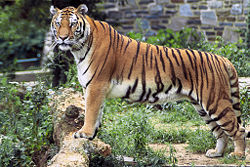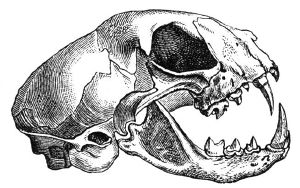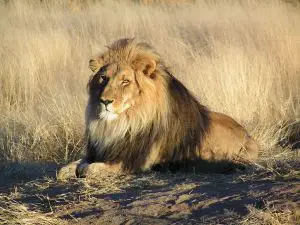Difference between revisions of "Felidae" - New World Encyclopedia
(starting work on article, the section on evolution seemed like a lot of speculation to me so I removed it) |
|||
| Line 6: | Line 6: | ||
| image = Panthera tigris tigris edited2.jpg | | image = Panthera tigris tigris edited2.jpg | ||
| image_width = 250px | | image_width = 250px | ||
| − | | image_caption = [[Tiger]] | + | | image_caption = [[Tiger]] |
| regnum = [[Animal]]ia | | regnum = [[Animal]]ia | ||
| phylum = [[chordate|Chordata]] | | phylum = [[chordate|Chordata]] | ||
| Line 12: | Line 12: | ||
| ordo = [[Carnivora]] | | ordo = [[Carnivora]] | ||
| familia = '''Felidae''' | | familia = '''Felidae''' | ||
| − | | familia_authority = | + | | familia_authority = G. Fischer de Waldheim, 1817 |
| subdivision_ranks = Subfamilies | | subdivision_ranks = Subfamilies | ||
| subdivision = | | subdivision = | ||
| − | + | Felinae<br /> | |
| − | + | Pantherinae<br /> | |
| − | + | †Machairodontinae | |
}} | }} | ||
| − | The '''Felidae''' [[family (biology)|family]] | + | The '''Felidae''' or '''cat''' [[family (biology)|family]] (also called '''felines''') is a part of the order [[Carnivora]] within the [[mammal]]s. It contains about 41 species including large animals such as the [[lion]] and the [[tiger]], as well as smaller ones such as the bobcat and the [[cat|domestic cat]]. |
| − | + | ==Characteristics== | |
| − | + | Like most other members of the Carnivora (carnivores), cats mainly get food by killing and eating other animals. They are more strictly carnivorous than most other carnivore families. The teeth of cats are well suited to their diet, with long canines for gripping prey and blade-like molars for cutting flesh. | |
| − | |||
| − | + | ==Role in nature== | |
| − | + | ==Felines and humans== | |
| − | |||
| + | ==Fossil felines== | ||
| + | The oldest known true feline (''Proailurus'') lived in the [[Oligocene]] and [[Miocene]] eras. During the Miocene it gave way to ''Pseudaelurus''. ''Pseudaelurus'' is believed to be the latest common ancestor of the two extant subfamilies and the extinct subfamily, Machairodontinae. This group, better known as the sabertooth cats, became extinct in the Late [[Pleistocene]] era. It includes the genera ''Smilodon'', ''Machairodus'', ''Dinofelis'' and ''Homotherium''. | ||
==Classification== | ==Classification== | ||
[[Image:Felis catus-skull-drawing.jpg|thumb|Wildcat skull]] | [[Image:Felis catus-skull-drawing.jpg|thumb|Wildcat skull]] | ||
| Line 36: | Line 36: | ||
** Subfamily [[Felinae]] | ** Subfamily [[Felinae]] | ||
*** Genus ''[[Felis]]'' | *** Genus ''[[Felis]]'' | ||
| − | **** | + | **** Chinese Mountain Cat (''Felis bieti'') |
| − | **** [[Domestic Cat]] ('' | + | **** [[Domestic Cat]] (''Felis catus'') |
| − | **** | + | **** Jungle Cat (''Felis chaus'') |
| − | **** | + | **** Pallas's Cat (''Felis manul'') |
| − | **** | + | **** Sand Cat (''Felis margarita'') |
| − | **** | + | **** Black-footed Cat (''Felis nigripes'') |
| − | **** | + | **** Wildcat (''Felis sylvestris'') |
*** Genus ''[[Prionailurus]]'' | *** Genus ''[[Prionailurus]]'' | ||
**** [[Leopard Cat]] (''[[Prionailurus bengalensis]]'') | **** [[Leopard Cat]] (''[[Prionailurus bengalensis]]'') | ||
| Line 105: | Line 105: | ||
*Lineage 8: ''[[Felis]]'' | *Lineage 8: ''[[Felis]]'' | ||
| − | |||
| − | |||
| − | |||
| − | |||
| − | |||
| − | |||
| − | |||
| − | |||
| − | |||
| − | |||
| − | |||
==References== | ==References== | ||
* Mott, M. (January 11, 2006). [http://news.nationalgeographic.com/news/2006/01/0111_060111_cat_evolution.html Cats Climb New family Tree]. National Geographic News | * Mott, M. (January 11, 2006). [http://news.nationalgeographic.com/news/2006/01/0111_060111_cat_evolution.html Cats Climb New family Tree]. National Geographic News | ||
Revision as of 17:02, 14 May 2007
| Felines[1]
| ||||||||||
|---|---|---|---|---|---|---|---|---|---|---|
 | ||||||||||
| Scientific classification | ||||||||||
| ||||||||||
|
Felinae |
The Felidae or cat family (also called felines) is a part of the order Carnivora within the mammals. It contains about 41 species including large animals such as the lion and the tiger, as well as smaller ones such as the bobcat and the domestic cat.
Characteristics
Like most other members of the Carnivora (carnivores), cats mainly get food by killing and eating other animals. They are more strictly carnivorous than most other carnivore families. The teeth of cats are well suited to their diet, with long canines for gripping prey and blade-like molars for cutting flesh.
Role in nature
Felines and humans
Fossil felines
The oldest known true feline (Proailurus) lived in the Oligocene and Miocene eras. During the Miocene it gave way to Pseudaelurus. Pseudaelurus is believed to be the latest common ancestor of the two extant subfamilies and the extinct subfamily, Machairodontinae. This group, better known as the sabertooth cats, became extinct in the Late Pleistocene era. It includes the genera Smilodon, Machairodus, Dinofelis and Homotherium.
Classification
- FAMILY FELIDAE
- Subfamily Felinae
- Genus Felis
- Chinese Mountain Cat (Felis bieti)
- Domestic Cat (Felis catus)
- Jungle Cat (Felis chaus)
- Pallas's Cat (Felis manul)
- Sand Cat (Felis margarita)
- Black-footed Cat (Felis nigripes)
- Wildcat (Felis sylvestris)
- Genus Prionailurus
- Leopard Cat (Prionailurus bengalensis)
- Iriomote Cat (Prionailurus iriomotensis)
- Flat-headed Cat (Prionailurus planiceps)
- Rusty-spotted Cat (Prionailurus rubiginosus)
- Fishing Cat (Prionailurus viverrinus)
- Genus Puma
- Cougar (Puma concolor)
- Jaguarundi (Puma yagouaroundi)
- Genus Acinonyx
- Cheetah (Acinonyx jubatus)
- Genus Lynx
- Canadian Lynx (Lynx canadensis)
- Eurasian Lynx (Lynx lynx)
- Iberian Lynx (Lynx pardinus)
- Bobcat (Lynx rufus)
- Genus Leopardus
- Genus Leptailurus
- Serval (Leptailurus serval)
- Genus Caracal
- Caracal (Caracal caracal)
- Genus Profelis
- African Golden Cat (Profelis aurata)
- Genus Catopuma
- Bay Cat (Catopuma badia)
- Asian Golden Cat (Catopuma temminckii)
- Genus Pardofelis
- Marbled Cat (Pardofelis marmorata)
- Genus Felis
- Subfamily Pantherinae
- Subfamily Felinae
Alternative classification
Genetic research gives a more concise classification for the cat family [2][1]:
- Lineage 1: Panthera, Uncia, Neofelis
- Lineage 2: Pardofelis, Catopuma,
- Lineage 3: Leptailurus, Caracal, Profelis
- Lineage 4: Leopardus
- Lineage 5: Lynx
- Lineage 6: Puma, Herpailurus, Acinonyx
- Lineage 7: Prionailurus
- Lineage 8: Felis
ReferencesISBN links support NWE through referral fees
- Mott, M. (January 11, 2006). Cats Climb New family Tree. National Geographic News
- Nowak, R. M., and J. L. Paradiso. 1983. Walker's Mammals of the World. Baltimore, Maryland: The Johns Hopkins University Press. ISBN 0801825253.
- Shoemaker, Alan (1996). 1996 Taxonomic and Legal Status of the Felidae. Felid Taxonomic Advisory Group of the American Zoo and Aquarium Association. Retrieved 2006-07-15.
- Turner, A. (1997). The big cats and their fossil relatives. Columbia University Press. ISBN 0-231-10229-1.
- University of California Museum of Paleontology (UCMP). 2007. Introduction to the Carnivora] Retrieved May 4, 2007.
- Voelker, W. 1986. The Natural History of Living Mammals. Medford, New Jersey: Plexus Publishing, Inc. ISBN 0937548081.
Credits
New World Encyclopedia writers and editors rewrote and completed the Wikipedia article in accordance with New World Encyclopedia standards. This article abides by terms of the Creative Commons CC-by-sa 3.0 License (CC-by-sa), which may be used and disseminated with proper attribution. Credit is due under the terms of this license that can reference both the New World Encyclopedia contributors and the selfless volunteer contributors of the Wikimedia Foundation. To cite this article click here for a list of acceptable citing formats.The history of earlier contributions by wikipedians is accessible to researchers here:
The history of this article since it was imported to New World Encyclopedia:
Note: Some restrictions may apply to use of individual images which are separately licensed.
- ↑ 1.0 1.1 W. C. Wozencraft, "Order Carnivora," in D. E. Wilson and D. M. Reeder (eds.), Mammal Species of the World: A Taxonomic and Geographic Reference. (Washington : Smithsonian Institution Press, 1993). ISBN 1560982179.
- ↑ W.E. Johnson et al.: The Late Miocene radiation of Modern Felidae: A genetic assessment. Science, Bd. 311, S. 73-77, Jan. 2006

